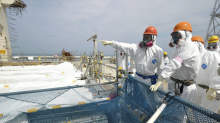Japanese minister visits Fukushima nuclear plant amid safety concerns
 Japan’s environment and nuclear minister visited the tsunami-crippled Fukushima Dai-ichi nuclear power plant on Saturday to inspect a spent fuel pool at the centre of safety concerns and said it appeared to have been properly reinforced.
Japan’s environment and nuclear minister visited the tsunami-crippled Fukushima Dai-ichi nuclear power plant on Saturday to inspect a spent fuel pool at the centre of safety concerns and said it appeared to have been properly reinforced.The visit by Goshi Hosono, apparently aimed at demonstrating the safety of the facility, came amid renewed concerns about conditions at the plant’s No. 4 reactor after its operator reported a bulging of the building’s wall. Nuclear regulators ordered a new investigation and seismic tests of the building and its pool.
The building was damaged by an explosion and fire soon after the Fukushima plant was hit by a massive magnitude-9.0 earthquake and tsunami on March 11, 2011. The pool, located at the top of the building above the reactor, remains one of the plant’s biggest risks due to its vulnerability to earthquakes.
The plant’s operator, Tokyo Electric Power Co., has reinforced the structure and says it now can withstand temblors as strong as last year’s quake.
A small group of journalists was allowed to enter the reactor building for the first time with Mr. Hosono. Inside there were piles of broken wall panels, pieces of cement and mangled equipment, showing the magnitude of the explosion.
Mr. Hosono, wearing protective coveralls and a full-face mask, climbed a narrow scaffolding to the fifth floor to see the pool, which was covered with a protective tarp. TEPCO officials lifted part of the cover to show the water surface.
Mr. Hosono later told reporters that he could see that the pool had been sufficiently reinforced.
“I could see steady progress being made toward removal of the spent fuel (from the pool), which is the next major goal,” he said.
The fuel rods in the storage pool are not enclosed as they are in reactor cores and could cause a greater release of radiation in case of a loss of water.
TEPCO is preparing to move the fuel rods from the pool to a joint pool for all six reactors next to the building, but the process won’t start until late next year. The joint pool is located on the ground level and is considered safer, even though it already has 6,000 fuel rods in it, officials said. It is expected to take 10 years before the removal of melted fuel from three damaged reactors can start.
Akio Komori, one of the TEPCO executives who escorted Mr. Hosono, said the company will inspect the No. 4 building to ensure its integrity while continuing with the fuel removal.
From early on, experts have raised concerns about the pool at the No. 4 reactor, where 1,535 fuel rods — the most of any of Fukushima’s six reactors — were stored because the reactor was undergoing major refurbishing and the fuel ordinarily inside its core was also kept in the pool.
U.S. nuclear officials feared the fuel rods would overheat and melt as water evaporated from the pool.
The pool had enough water to cover the rods, but officials recently said they might have been saved by chance.
When the disaster struck, two additional pools next to the fuel storage pool had been temporarily filled with water to store equipment used during the refurbishing. That water flowed into the fuel rod pool as its water level declined, though it’s not clear whether the rods would have been exposed otherwise, Nuclear and Industrial Safety Agency official Masaru Kobayashi said.
A worst-case scenario envisioned by the head of the Japan Atomic Energy Commission two weeks after last year’s accident warned that a melting of the fuel rods at the No. 4 reactor would require the evacuation of 30 million people just from the greater Tokyo area.
You can return to the main Market News page, or press the Back button on your browser.

